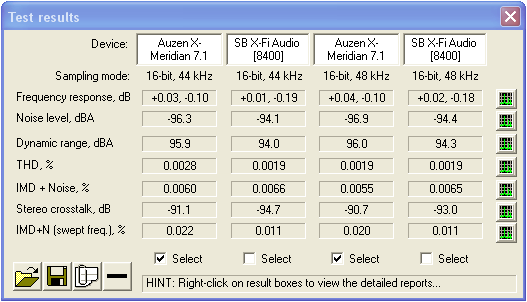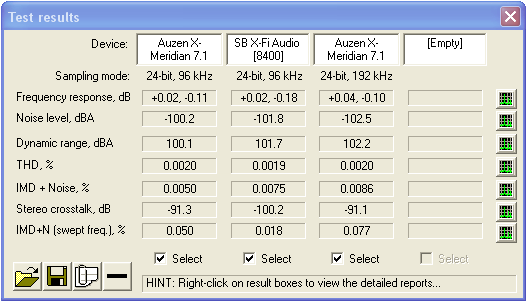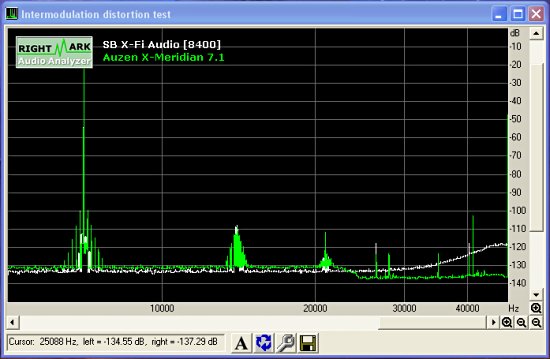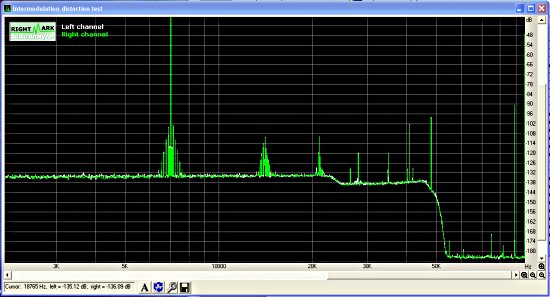Page 9 - Benchmarks RMAA
Performance RMAA & RM3D
There were years where just about every new review also came with a new RMAA version. Now that the current RMAA 5.5 has been around for quite some time, I miss the development. Anyway, lets have a gander at the electrical characteristics of the X-Meridian.
We have to split the results into two sections, the 16-bit tests above, and the 24-bit tests below.

The initial 16-bit numbers look excellent for the X-Meridian. However, notice the incredible similarity of the THD (Total Harmonic Distortion). I believe we hit a recording input limit with the X-Meridian.

Now, why is the X-Meridian measuring ~100dBA dynamic range, when the quoted spec is 120dB? What we are really looking at is how good the recording performance is for the X-Meridian verses our reference X-Fi. It is not a card geared for recording. It is pretty good, though.
The one problem that I run into every time with RMAA 5.5 is how difficult it is to get Windows to do anything related to recording. So, these numbers may not even be reliable, which would be for shame. Vista will be a large improvement here, with its Universal Audio Architecture. The second problem here is that while the X-Fi has an audio creation mode that you can access its native processing mode for the best performance, the X-Meridian did not want to budge from a 16 bit/48 KHz mode. I know it can do it, as it does it with Foobar2000 in kernel streaming mode, but just not with RMAA.
If we take a look at the IMD (intermodulation distortion) plot, we can see where the X-Fi has a very clean plot all the way up to the Nyquist limit of 48KHz for the 96KHz samplerate. The X-Meridian has a drop at around 24KHz which implies a 48KHz sampling rate (the upper limit of the Nyquist frequency), or hefty anti-aliasing. The best way to describe it is whacky.

IMD with X-Meridian and X-Fi at 24-bit/96KHz sampling rate.
It looks to me like the X-Meridian is doing noise-shaping above 22KHz to clean up its output. Basically, with noise shaping you shift quantation noise (errors introduced by truncating/dithering 24 bits to 16 bits, for example) up into inaudible regions, above 22KHz. Notice the rather nice curve of the X-Fi, which means it is working natively at 96KHz sampling rate.
Let's take a look at the 24 bit/192KHz samplerate to see if things improve.

X-Meridian at 24-bit/192KHz.
Above 20KHz we see the full noise shaping in action, with a slight rise up to 48KHz, and then I assume some anti-aliasing takes over around 50KHz. I'm guessing anti-aliasing because of the sharp drop off well before the 192KHz frequency response limit of 96KHz. Whatever process it is doing thankfully does not introduce a lot SRC errors that we commonly found with the Audigy series.
Slightly disturbing results for a 24bit/192KHz sound card that seemingly only works at 48KHz! If it is just a driver issue, (or reviewer malfunction) then we can only assume better results in the future. However, currently the Creative X-Fi and its potent DSP is superior, but only just barely.
These are the very last tests we run, mainly because yours truly does not want the knowledge of numbers during objective listening. I can say, though, that the X-Meridian sounds, much, much better than what we measured. My guess is that the X-Meridian is limited by its recording capability in these tests.
